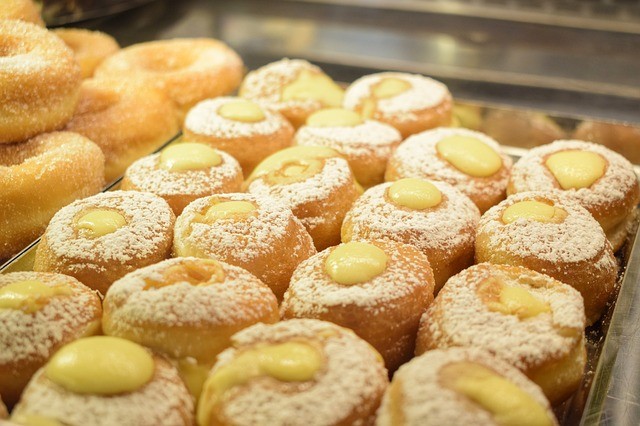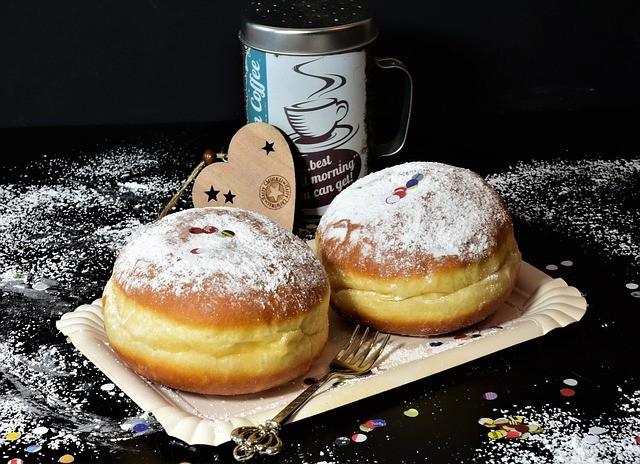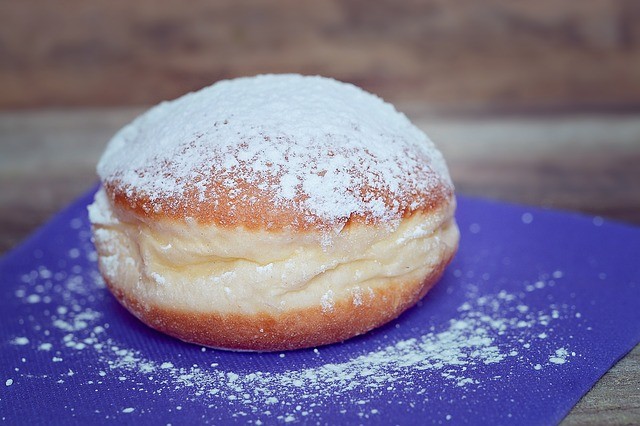An Italian pastry called bomboloni has crossed the Atlantic Ocean to take the United States by storm.
Similar to American jelly doughnuts, this light treat is usually filled with a tasty fruit preserve or cream.
Are you curious about bomboloni donuts? Are you looking for a bomboloni recipe simple enough to follow along at home, yet just as delicious as if you bought them at an Italian bakery?
You’ve come to the right place.
In our complete guide to bomboloni, we walk you through the origins of this delicious treat – plus how to make it, the ingredients you will need, and what to fill it with.
Let’s take a look…
What is Bomboloni?

Bomboloni are kind of like sourdough donuts. Though originating in Europe, these sweet treats are growing in popularity all over the United States, in bakeries, restaurants, and homes alike!
Let’s learn some more about the origins of bomboloni donuts.
History and Origins
Bomboloni are also known as “krapfen” or “kraffen” in their home nation of Italy. These delicious donuts originated in a specific part of Italy, known as Trentino Alto-Adige, which was once under the rule of Austria.
As a result, Italian cuisine combined with Austrian and Bavarian influence to create this traditional treat in the late 1600s!
Records vary on why these treats were known as “krapfen.” Some say that it comes from the German word for pancake, “krafo.”
Others say that the dessert was invented by a woman with the last name of Krapft, a pastry chef in either Vienna or Tuscany.
Bomboloni, with the singular word form of “bombolone,” were originally a dessert typically eaten during Carnival, a Christian holiday featuring a great banquet just before the fasting period of Lent.
These days, however, bombolini are famous enough that they are eaten the whole year round!
Today you can find this donut-like pastry in cafés from Florence, Italy, to San Francisco, California. In some regions of Italy, the name is shortened to “bomba” or “bomb.”
A similar donut is found in Tunisia in Northern Africa, as well, though on that side of the Mediterranean Sea, it is known as bambalouni.
The bombolini are an airy, sweet pastry made of leavened dough, once fried in lard but now more likely to be fried in oil.

Lard was also a common ingredient in the dough of the bombolini itself, though these days the lard is usually swapped out for butter or margarine instead.
It has a light, hollow interior that bakers usually fill with jam, cream, or custard. Depending on what kind of filling you pick, and how much filling you use, these donuts can vary widely in their flavor and number of calories!
Though there is very little sugar in the dough of the bombolini itself, some bakers like to dust the donut with sugar at the end for an added dose of sweetness!
The bombolini comes out tasting like a kind of pudding surrounded by a donut so nice and fluffy that it could melt in your mouth – an exquisite combination of flavors and textures. It can be a bit messy to eat, but so are all of the most delicious desserts!
Bomboloni vs. Donuts
Though it is accurate to refer to bombolini as “donuts,” there are a few differences between the Italian bombolini and what Americans usually think of when we say the word “donut.”
For one thing, the American donut usually has a hole in the center, while the bombolini is like a jelly doughnut, made completely round and intended to be filled with a custard, jam, or cream.
While American jelly doughnuts are usually filled from the side, bombolini are usually filled from the top, creating a cute button-like design. American donuts have a much more cake-like quality to them, far more dense and sweet than the typical bombolini.
Bombolini are also made with yeast, while American donuts are not. The yeast dough for a bombolini donut, similar to sourdough, may be prepared a day in advance and left to rise in the fridge overnight.
Then, the next day, it’s time to roll, cut, fry, and fill the donut!
Here’s an example of a bomboloni recipe.
How to Make Bomboloni
If you have followed a sourdough donut recipe before, then this bomboloni recipe might seem familiar.
It might seem like a lot of work, but the product (and the happiness of your stomach) makes these donuts well worth the effort!
Here are the recipes and procedure for making bombolini at home.
Ingredients
Here is what you should have in your kitchen before making your bomboloni.
For the levain:
- Sourdough starter (ripe 100% hydration starter, 6 tablespoons or 45 grams)
- All-purpose white flour (3/4 cup)
- Water, room temperature (3/4 cup)
For the bomboloni dough:
- All-purpose white flour (2 cups)
- High protein bread flour (2 cups)
- Eggs (3 large and 1 yolk, cold from the fridge)
- Butter (7 tablespoons)
- Fine white sugar (1/2 cup)
- Water (3/8 cup)
- Salt (2 teaspoons)

Step By Step Method
First, build the levain; this is the base of the recipe, which will make the donuts rise. Combine the sourdough starter, the all-purpose white flour, and the room temperature water to create the levain.
Store the levain in a warm place, around 78 degrees Fahrenheit, until ripe. This may take about five hours, so these first steps should take place well before you plan to bake the rest of the donut. It is easy for working bakers to get the levain started before their day job begins, and continue the donut baking process in the afternoon!
Next, measure out the butter, cutting it into chunks about a half an inch long. Let the butter soften at room temperature while you mix the other ingredients together.
Crack three full eggs into a small bowl, and add only the yolk from a fourth egg. Lightly whisk the eggs together to break the yolks and incorporate them.
In a mixing bowl, combine the eggs, the all-purpose white flour, the high protein bread flour, the fine white sugar, the levain you prepared earlier, the salt, and the cold water. Mix them together to create the dough, adding a little more water if the dough turns out to be overly dry.
If using an electric mixer, set it to “stir” mode for about a minute before setting it to a higher speed for about five minutes, to combine the ingredients together. The dough should begin to clump up around the paddle.
Once the dough has begun to clump up around the paddle, but is still sticking to the bottom and sides of the bowl, let it rest for about ten minutes.
While the dough is resting, check your butter for how much it has softened. It should be pliable enough to show an indent when lightly pressed with a finger, but should not be fully melted. Briefly microwave for about ten seconds if it is not yet soft enough.
While mixing the dough, add the butter to the dough mixture one small chunk at a time, allowing each to absorb into the dough before you add the next chunk to the bowl. This should take between nine and ten minutes.
As you mix the dough, pause periodically to scrape down the sides and paddle, making sure that everything is evenly mixed. You will need to do this several times throughout the mixing process.

To see whether the dough is prepared sufficiently, test it by grabbing a chunk of the dough with wet hands and gently spreading it out with your fingertips. If the dough is mixed enough, it will stretch into a thin membrane that will just barely begin to rip when stretched.
When the dough has been mixed enough to be appropriately stretchy, transfer it to a container for fermentation. In total, you should allow the dough to ferment for six hours at 78 degrees Fahrenheit.
For the first two hours into fermentation, every thirty minutes, stretch and fold the dough. This will include a total of four sets of stretch and folds.
After the last set of stretching and folding, about two hours into the fermentation process, allow the dough to rest for the remaining four hours.
After six hours of fermentation, the dough should have risen by around 30 percent volume. Place the dough into the fridge overnight for the rest of the fermentation process. The dough can continue to rest in the fridge for twelve hours or more, so you can continue the baking process whenever it is most convenient for you!
The next day, take the fermented dough out of the fridge and dump it out onto a non-floured counter or another work surface. The dough will feel rather stiff and cold to the touch.
If you would like, apply a small amount of flour to your hands to avoid the dough sticking to your skin. Keep the flour to a minimum, because maximum friction between the counter and the dough is ideal for creating the donut rounds.
Divide the dough into 18 pieces, about two ounces each. You may have some dough left over.
Using your hands, shape the pieces of dough into rounds. Make sure that each donut round has a taut surface with no seam on the bottom. You can push the round against the counter with the side of your hand in order to tighten up the surface.
Next is the proofing process. Dust a large, covered baking sheet liberally with flour. Make sure that there is enough room for each of the rounds to expand in the pan! Use two or three sheets, or some extra storage containers or pizza trays, to ensure an appropriate amount of space for each donut.
Place the rounds into the trays, cover the trays, and set them in a warm spot, once again around 78 degrees Fahrenheit. Leave them to proof for about twelve hours.
After twelve hours, the donut rounds should be almost double in size, and very puffy and delicate to the touch, as though completely filled up with air.

Be sure not to end the proofing process too soon!
You can, however, pause the proof a few hours before it is complete and finish again at another time. Proofed dough can be refrigerated and fried later, but the bombolini may not fry at the same height if you do.
While you set up your frying station, you may want to place the fully-proofed dough trays into the refrigerator, to make the rounds a little more firm for the transfer between the trays and the oil.
Fill your combo cooker to about two-thirds capacity with frying oil, such as vegetable oil or coconut oil. Set the cooker over medium heat until the oil registers between 360 and 370 degrees Fahrenheit. Use a frying thermometer on the side of the pot to gauge the temperature.
Gently transfer one donut round from the proofing tray to the oil, so that the smooth top of the dough is placed downwards into the oil. Let it fry on this side for two and a half minutes, and then flip the dough to fry the other side.
Once fully cooked, transfer each bomboloni to a baking sheet or cooling rack.
If desired, dust the bomboloni with sugar, and fill them with a tasty jam or cream!
What to Fill Bomboloni With
You have a lot of options when it comes to filling your bomboloni. It is traditional to fill these pastries with apricot or plum jam. Other fruit preserves or marmalade fillings work just as well.
It is common in Italy for bomboloni to be filled with vanilla cream or custard. Restaurants in New York sometimes serve bombolini with chocolate sauce, both as a filling and as a drizzle on top of the donut with the sugar. Other bakers choose nutella for the filling!
Some bombolini cafés in the United States have expanded their selection to tiramisu, blood orange, peanut butter, toasted marshmallow, and even passion fruit, so choose whatever flavor your taste buds want most!
Here’s a video showing how to make nutella bomboloni.
Now you’re ready to make your own bomboloni!
